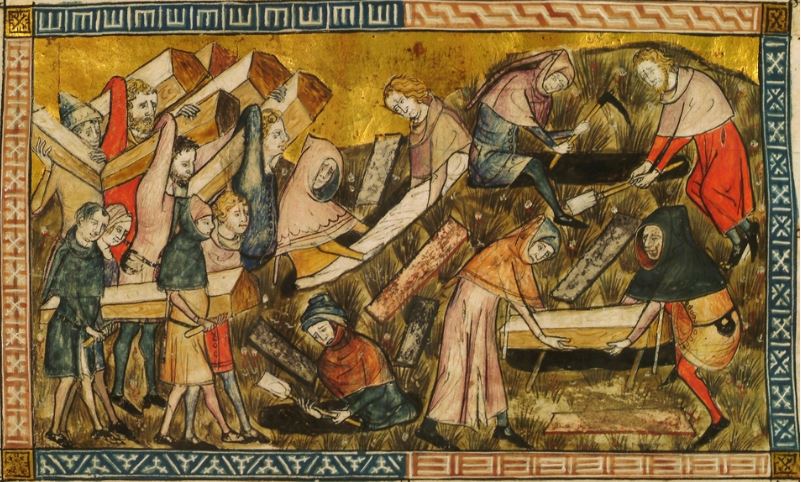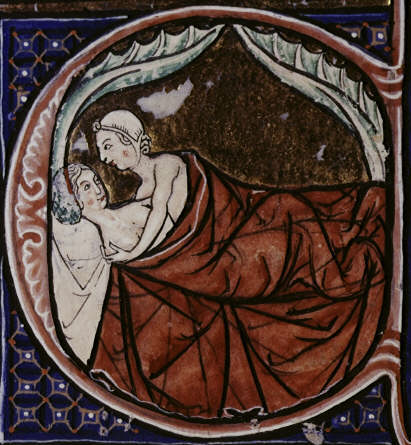Katherine Harvey
In recent weeks, as fears about coronavirus have spread across the world, various explanations for the emergence of this new disease have been proposed with most of them focusing on animal-human transmission and a live-animal market in Wuhan. But for some, the explanation is less scientific: according to the US evangelical pastor Rick Wiles, the outbreak is due to the fact that ‘There are vile, disgusting people in this country now, transgendering little children, perverting them. Look at the rapes, and the sexual immorality, and the filth on our TVs and our movies.’

When such outrageous views are expressed, they will almost inevitably be described as medieval, as they seem to belong to the distant past. And there is some truth in this, as some medieval people did view epidemics, especially the Black Death, as a punishment for immoral behaviour. In October 1348, William of Edington, bishop of Winchester, sent a letter to clergymen across his diocese, warning them of the impending threat of plague, and suggesting that
it is to be feared that the most likely explanation is that human sensuality- that fire which blazed up as a result of Adam’s sin and which from adolescence onwards is an incitement to wrong doing- has now plumbed greater depths of evil, producing a multitude of sins which have provoked the divine anger, by a just judgement, to revenge.
Trusting in God’s mercy, he thought there was still chance to avert disaster if the faithful made full confession of their sins and engaged in penitential processions and other religious devotions. Unfortunately, this turned out to be a false hope, and England would be troubled by plague epidemics until the seventeenth century. Consequently, a quarter-century later, another bishop preached that lechery and adultery were to blame for another outbreak of plague: too many men kept mistresses and fathered bastards, ‘behaviour which merits a horrible and wretched death.’ Thomas Brinton of Rochester urged lechers to give up ‘living dangerously and serving your body in filthiness’, and to turn back to God.
As a consequence of such concerns, outbreaks of pestilence sometimes led to campaigns against sexual offenders, which were surely intended to pacify God as well as to reassert social order in difficult times. In Ipswich, a campaign against suspected brothels began during the 1465 plague epidemic leading to at least fifteen prosecutions. Five years later, during another serious outbreak, the town ordered the expulsion of all ‘harlots and bawds.’ At the same time, prosecutions for fornication and adultery (which were rare in the town before this date) became considerably more frequent.
But even in the fourteenth century, not everyone explained the plague in terms of sin. Many medical authorities discussed it in purely scientific terms. In October 1348, a report by the Paris medical faculty outlined what it believed to be the causes of plague: planetary conjunctions, bad air (perhaps from rotting corpses or earthquakes), and unseasonable weather. Those who would be particularly vulnerable to the disease included the physically weak (i.e. babies, children, and women), persistent worriers, and ‘those following a bad lifestyle, with too much exercise, sex and bathing.’ Adopting ‘a sensible and suitable regimen’ was the best way to protect oneself.
Sex was always potentially dangerous, especially for men, because it caused humoral imbalances and weakened the body. Indeed, medieval medical theory suggested that it was possible for even a perfectly healthy man to die if he overindulged. But sex became particularly dangerous during an epidemic, as highlighted by the plague tract which a fifteenth-century Yorkshire gentleman copied into his commonplace book. It advised the reader to avoid gluttony, baths and sweating, but also sex, which weakened the vital spirits just as they were needed to fight the disease.
Concerns about sex were linked to the belief that bad air played a key role in spreading the disease. It was therefore thought prudent to avoid any activity which would heat the body and open the pores in the skin allowing bad air in. One widely circulated treatise, written by the papal physician Jean Jacmé in the mid-1360s, explained why some succumbed to plague whilst others did not. Amongst his theories was the suggestion that ‘where bodies have open pores, as in the case of men who abuse themselves with women or often have baths, or men who are hot with labour or great anger, they are the more disposed to this great sickness.’ He therefore advised readers to avoid ‘every fleshly lust with women.’

Jacmé also suggested that the healthy should keep away from the baths. Given that medieval bathhouses were often linked to sexual assignations, it is sometimes assumed that such advice was based on the need to avoid sin. In this case, however, it clearly had a strong medical basis: the doctor was concerned with sex as a medical danger, and also recognised the risk of contagion through ‘infectious breath.’ Similarly, John Lydgate (c. 1370-c. 1451) recommended that those who wanted to avoid sickness should keep away from the bathhouses, in order to avoid both ‘incontynence’ and warm, infected air. These warnings highlight the complexity of medieval attitudes to plague. Although there was undoubtedly a great deal of concern about sin, there was also a lot of sensible advice based on the latest medical theory.
If God really did send the Black Death to teach medieval sinners a lesson, the strategy seems to have had limited success. Perhaps some did abstain during epidemics, hoping that this would save their lives. But many writers (often those who considered sin to have caused the plague) continued to fret about sexual conduct even once the worst seemed to have passed. Writing after the 1361 outbreak, which killed many men but few women, Ralph Higden complained that many widows chose to ‘couple with their inferiors’, marrying imbeciles, madmen, or even foreigners. John of Reading, describing the aftermath of the same epidemic, also accused widows of marrying foreigners or kinsmen, and even claimed that ‘in many places brothers took their sisters to wife.’ In the aftermath of the Black Death, he suggested, many people ‘regarded fornication, incest or adultery as a game rather than a sin.’
Ultimately, people have always panicked about pandemics, and people have always panicked about (what they perceive to be) unacceptable sexual practices. It is, perhaps, inevitable that some people combine their fears, and conclude that the former is caused by the latter. If there is a lesson to be learned from medieval responses to the Black Death, it clearly is not that disease is a punishment for sexual sin. Nor is there any evidence to suggest that giving up sex will protect you from either coronavirus or bubonic plague. Indeed, current medical thinking suggests that it might actually help us to stay healthy. Nevertheless, it is worth remembering that, alongside the bad advice, some medieval preventative strategies — quarantining the sick and burning the bedding of those who died — were both sensible and effective. All medical crises provoke a cacophony of opinions; the challenge for us is to decide which are irrational, and which are worth listening to.
 Katherine Harvey is a medieval historian based at Birkbeck, University of London. She is the author of Episcopal Appointments in England, c. 1214-1344 (Ashgate, 2014), and is currently writing books on ‘The Episcopal Body in Medieval England’ (for OUP) and ‘Sex and Sexuality in Medieval Europe’ for Reaktion. She tweets from @keharvey2013
Katherine Harvey is a medieval historian based at Birkbeck, University of London. She is the author of Episcopal Appointments in England, c. 1214-1344 (Ashgate, 2014), and is currently writing books on ‘The Episcopal Body in Medieval England’ (for OUP) and ‘Sex and Sexuality in Medieval Europe’ for Reaktion. She tweets from @keharvey2013

NOTCHES: (re)marks on the history of sexuality is licensed under a Creative Commons Attribution-NonCommercial-NoDerivatives 4.0 International License.
Based on a work at www.notchesblog.com.
For permission to publish any NOTCHES post in whole or in part please contact the editors at NotchesBlog@gmail.com





I really enjoyed reading this. You can just see how scared people were, and trying to do their best with the knowledge they had. I feel very lucky to live in an evidence based peer reviewed 21st century. I wonder how much influence the people in the religions and medical professions had on each other’s views of the plagues.